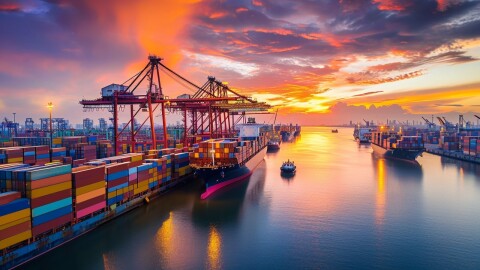Moving compute workloads from on-premises data centers to the cloud can improve energy efficiency and reduce carbon footprint by more than 78% for customers in APAC, according to a new study of enterprises and public sector organizations by 451 Research. Commissioned by AWS, the report surveyed 515 organizations with annual revenues between US$10 million and US$1 billion across Japan, South Korea, Singapore, Australia, and India.
Despite the tropical climate, on-premises data centers in Singapore are among the most efficient in APAC and Singaporean data centers are the only ones surveyed who outperformed the APAC average, due to a couple of factors. First, Singapore enterprises and public sector organizations consolidate workloads more, which drives up utilization and efficiency. Second, organizations here are relatively early adopters of the latest server technology and refresh their servers faster on average.
451 Research found that on-premises data centers across APAC typically have a server utilization rate of just under 15%, whereas cloud-based data centers using servers powered by the latest processors and with utilization of 50% or more achieve peak efficiency. Given this difference in utilization, the report determines that cloud servers are able to achieve energy savings of more than 67% compared to typical on-premises servers, due to their practice of using the most up-to-date servers more efficiently.
Cloud servers save energy due to their practice of using the most up-to-date servers more efficiently. For example, AWS’s custom-built Graviton2 processors—offered exclusively to AWS customers—provide better performance per watt than any other Amazon Elastic Compute Cloud (Amazon EC2) processor. Amazon EC2 is a web service that provides secure, resizable computing capacity in the cloud.
The research also found that cloud-based data centers offer further potential energy savings of more than 11% due to their highly energy-efficient power and cooling systems.
AWS is constantly innovating the design and application of cooling systems to reduce water use, and we utilize real-time sensor data to adapt to changing weather conditions. Where we can, we use reclaimed or recycled water instead of potable drinking water, we work with local utilities to expand the use of reclaimed water, and we look for opportunities to return water to the community. AWS’s water use strategy evaluates climate patterns for each AWS Region, local water management and availability, and the opportunity to conserve drinking water sources.
In Singapore, enterprises and public sector organizations moving to the cloud see an average workload energy reduction of up to 76%, which amounts to 1,542 metric tons of carbon per megawatt of data center capacity per year. Greater access to renewable energy resources for cloud providers would result in additional emissions removal of up to 434 metric tons per year, compared with the grid baseline. Powering cloud services with 100% renewable energy would bring total workload energy-related carbon reductions to 1,976 metric tons per megawatt per year.
Customers migrate workloads from on-premises data centers to AWS to tap into our global infrastructure and broadest selection of services to increase agility, drive innovation, and achieve cost savings, among other advantages. Moving to AWS is also much more sustainable than on-premises infrastructure because AWS has always focused on energy efficiency and continuous innovation in our data centers. We closely track our resource usage to optimize utilization, reduce energy, and increase operational excellence. Our scale allows us to achieve much higher resource utilization and energy efficiency than the typical on-premises data center, especially since the AWS Global Infrastructure is built on Amazon’s own custom hardware - purpose-built and optimized for workloads run by AWS customers.
Accelerating Maxeon Solar Technologies’ sustainability goals
Beyond providing cost savings and process efficiency, AWS is committed to empowering Singaporean customers with the tools to innovate towards their own sustainability solutions on the cloud. For example, Maxeon Solar Technologies, a global leader in solar innovation headquartered in Singapore, have decided to go all-in with AWS Cloud in Singapore to make their operations more efficient to better focus on customers in over 100 countries and contribute to their own sustainability goals. Maxeon Solar Technologies worked with AWS on an accelerated plan to migrate their enterprise workloads from a physical data center to the AWS Cloud in three months.
“At Maxeon, our solar products are Powering Positive Change in more than 100 countries worldwide,” said Lindsey Wiedmann, Chief Legal Officer and Global ESG Executive Leader at Maxeon Solar Technologies. “The solar industry is a critical part of the fight against climate change and at Maxeon, we continue to push the boundaries of innovation in order to deliver more industry-leading solar technologies around the world and create a better future for our planet. Now, with the support of AWS and the power of cloud computing, we are better able to achieve our business goals in a sustainable way, leveraging AWS’s operational efficiency, reliability and security to drive faster innovation in solar.”
Unlocking more renewable energy for the region
Amazon is on a path to powering all our operations with 100% renewable energy by 2025, five years ahead of our original target. As the world’s largest corporate buyer of renewable energy, Amazon has enabled 232 wind and solar projects worldwide.
451 Research estimates that emissions savings for organizations moving from on-premises data centers to cloud could rise to 93% if cloud data centers in APAC were powered by 100% renewable energy. This finding was especially important for the Asia Pacific region, as the study reported that the lack of accessible and affordable corporate renewable energy options in the region left a significant amount of carbon reduction potential on the table.
Amazon has invested in five renewable energy projects in Asia. These include three wind and solar projects in Australia, one solar project in China, and a 62MW solar project in Singapore consisting of multiple moveable ground-mounted solar panels. Collectively, these projects will supply more than 900,000 MWh of additional renewable energy to local electricity grids.
Climate change is one of the most critical challenges we face. At Amazon, we are committed to building a sustainable business for customers and the planet, which is why we co-founded The Climate Pledge in 2019, a commitment to reaching net zero carbon by 2040, 10 years ahead of the Paris Agreement. Over 100 companies have now joined us in the pledge. By investing in renewable power and ensuring our facilities and operations are energy efficient, we can provide our customers with the computing power they need to solve innovative challenges while reducing their overall impact on the environment and meeting their own sustainability ambitions.
To learn more, read the full report.











